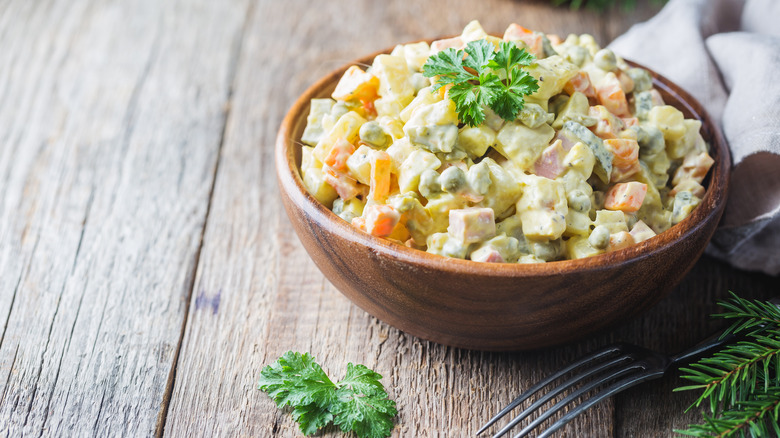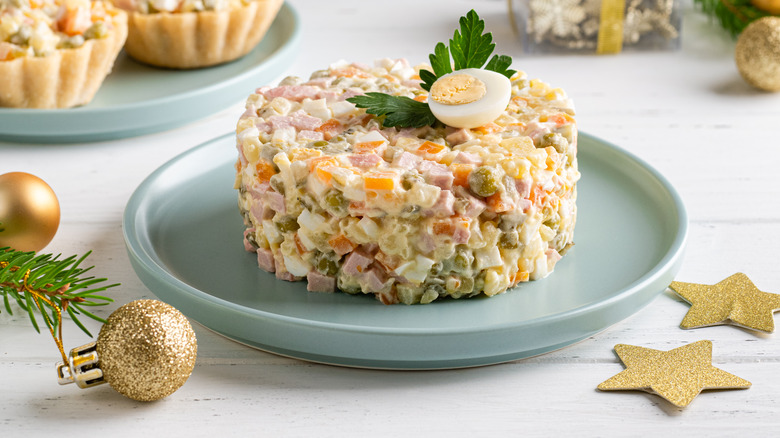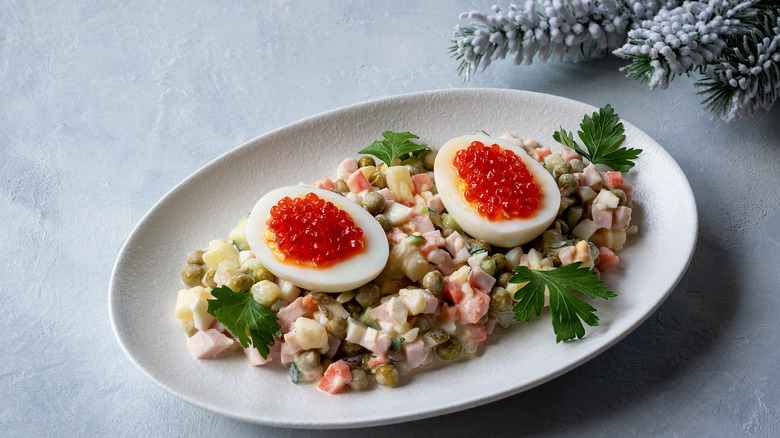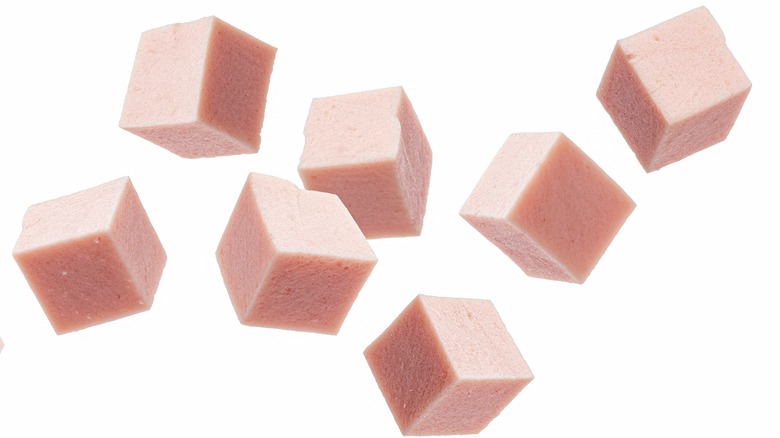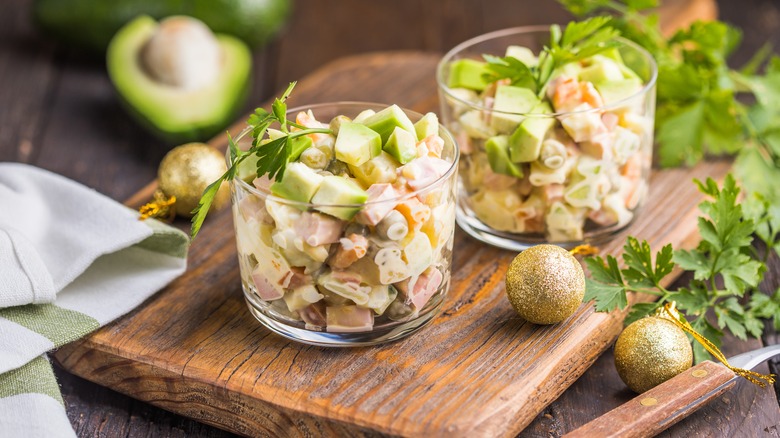What Makes Russian Potato Salad Unique?
When it comes to potlucks, quantity doesn't need to sacrifice quality. A nod to the casseroles, pasta salads, and potato salads out there, whether at a barbecue or during the holiday season, such dishes instill a convivial comfort. And it's easy to see why — what possibly beats a holiday spread?
In Russia, such festive dining culminates during New Year's Eve. The table is covered in a wide range of dishes, consumed in small portions between sips of vodka. The spread typically features splurges like fish roe, comforts like mini-pancakes called blini, and a dependable stalwart in the salad Olivier, explains Bon Appétit. Also called Russian potato salad, this mixture of spuds, mayo, and other components works magic, especially when bolstering booze. Plus, the essential holiday dish can be prepped in large quantities, meaning there's a lot left over for the next day, notes iTMO News. It's fair to say Russian potato salad often steals the show at celebrations, and understandably so. Let's dig into what makes it so unique.
What is Russian potato salad?
Russian potato salad, or salad Olivier, is a staple of Russian and Ukrainian cuisine. Especially noted for its inclusion on New Year's and other celebrations, it's a dish where the sum truly outweighs its parts. In fact, its accessible taste and preparation has made it popular worldwide in cuisines as varied as Spanish, Iranian, and Latin American, notes Peter's Food Adventures. The salad comes together with boiled potatoes, pickles, peas, eggs, and a protein, typically ham, but sometimes chicken or beef. Most importantly, it's covered in a generous amount of mayo, which, combined with potatoes, defines the dish, per Russia Beyond.
Recalling the same comforting nostalgia as other potato salads, Olivier is malleable. Emphasis is placed on varying textures, with anything on hand an acceptable addition. And unlike potato salads stateside, the inclusion of meats can make this dish the star of the show, via CopyKat. Simultaneously a fridge-cleaning meal or a canvas for unusual flavors, the salad's origins explain its malleability.
The origins of Olivier salad
The salad owes its name to a Belgian chef named Lucien Olivier, who helmed the Moscow restaurant Hermitage in the 1860s. To cater to the upscale tastes of his Parisian-inspired menu, Olivier created a lavish concoction that was quite different from the modern rendition. Made with black caviar, game hen, tongue, crayfish tails, and a mayo-like Provencal dressing, the only shared element with today's version is the humble potato. Chef Olivier intricately arranged such decadent components only to find diners immediately mixed everything together. He went on to pre-blend the potato and other elements in the creamy mayo dressing, a move fundamental to the salad's invention, explains Folkways.
Many dishes similar to Olivier's spread throughout 19th-century Europe, along with a wave of French-inspired fine dining cuisine. Not until the Soviet Union was formed did the salad transform into its modern form. Lavish ingredients were substituted with cheaper, more easily-accessed replacements: Potatoes, peas, mayo, and pickles (per Carusel). Now, the dish can encompass additions from both affordable origins and special treats. Cubes of everyday ingredients like Doctor's Sausage, basically bologna (via Understand Russia), can be served right alongside caviar.
How to prepare Russian potato salad
Of course, Russian potato salad starts with its namesake — spuds. Vladimir Ocokoljic's recipe for The New York Times Cooking is a straightforward pick by simply using medium-sized yellow potatoes. The taters are accompanied by carrots, peas, ham, and eggs, all boiled. The chef swears by cornichons for an acidic kick, combining their brine with mayo. Such an addition keeps the dressing liquidy, avoiding an overly dense salad.
The salad Olivier's assembly is much like others — lot's of dicing. Since the texture is paramount, each component should be cubed uniformly and, if overly soggy, drained. Veggies should be iced after boiling and home chefs should avoid cooking with canned peas. A fresh crisp is always preferable, which will prolong the storage of this tasty goodness for three days. Once prep work is complete, simply combine all components with mayo and enjoy, notes Cookist. Since it's served cold, Russian potato salad is also well-suited to prep in advance. Veggies can easily be pre-boiled before assembly; cooling them is recommended. Many cooks even swear the salad tastes better after a night in the fridge (via iFoodReal).
Russian potato salad variations
There are few ways to go wrong with Russian potato salad as the recipe has been adapted into many variations worldwide. In Spain, the dish goes by Ensaladilla Rusa or little Russian salad. While still founded upon the same base of potatoes and mayo, Medditerarean flavors are brought into the mix: Paprika, stuffed olives, olive oil, and roasted peppers (per The Spanish Radish). In Iran, it's known as Olivier, and a lighter yogurt dressing is often substituted for mayo, explains Oven Hug.
Writing for The Guardian, Felicity Cloake chronicles the impressive range of variations to the salad. Some renditions forgo potatoes altogether, exchanging them for turnips. Italians might add pickled cauliflower, while apples and beans appear in a Polish variety. Sometimes the dish can be a vehicle for seafood, featuring shrimp or caviar. And the dressing is an opportunity to get creative, with components like mustard or condensed milk imparting an extra zing. No matter how you mix it, Russian potato salad hits the right notes. Unique and satisfying, this dish always warrants a spot on the dining table.
